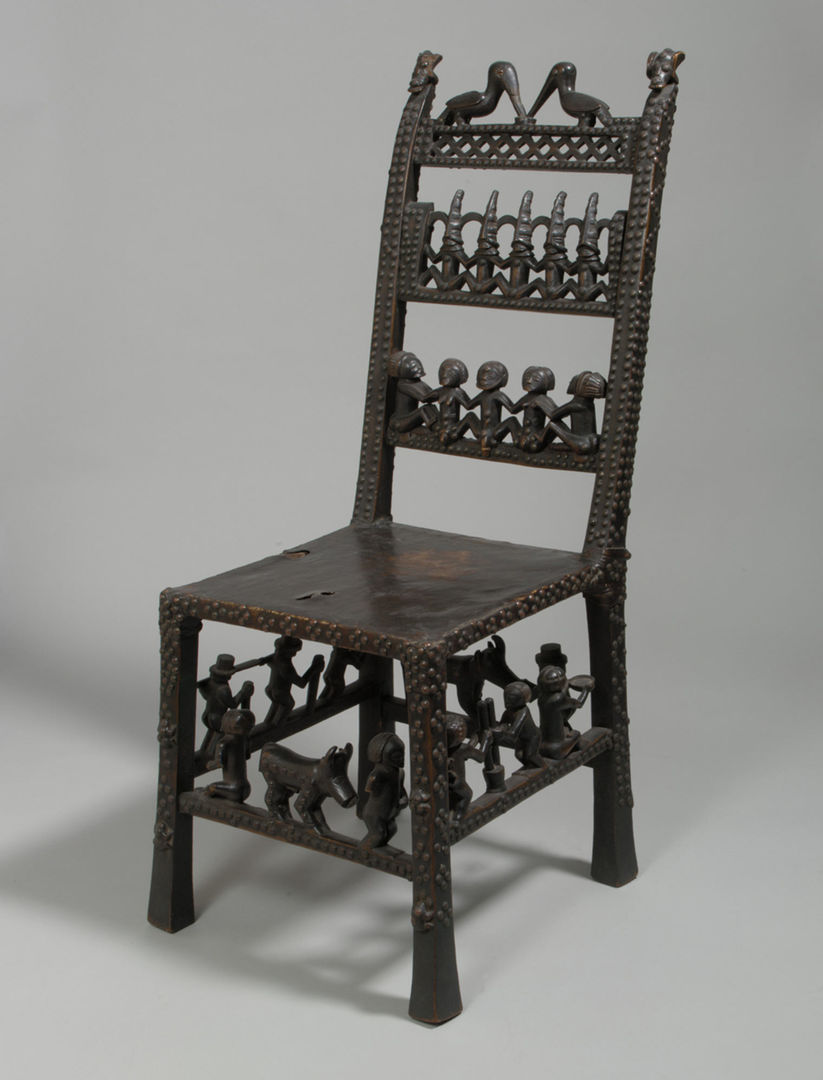The Power behind the Throne

Chair (Ngumdja), 19th–20th century. Angola; Chokwe peoples. Wood, brass tacks, leather, 39 x 16 15/16 x 23 1/8 in. (99.1 x 43 x 58.7 cm). The Metropolitan Museum of Art, New York, The Michael C. Rockefeller Memorial Collection, Purchase, Nelson A. Rockefeller Gift, 1970 (1978.412.619)
Collection Area: African Art
Subject Areas: English Language Arts, Visual Arts, World History
Grades: Middle School, High School
Topic/Theme: Power and Leadership
Goals
Students will be able to:
- use visual evidence to support interpretations of a work of art; and
- use surface detail and composition to convey power and leadership in a work of art.
National Learning Standards
English Language Arts
NL-ENG.K-12.4 Communication Skills
NL-ENG.K-12.7 Evaluating Data
NL-ENG.K-12.9 Multicultural Understanding
Visual Arts
NA-VA.K-12.2 Using Knowledge of Structures and Functions
NA-VA.K-12.3 Choosing and Evaluating a Range of Subject Matter, Symbols, and Ideas
NA-VA.K-12.4 Understanding the Visual Arts in Relation to History and Cultures
NA-VA.K-12.6 Making Connections between Visual Arts and Other Disciplines
World History
NSS-WH.5-12.7 Era 7: An Age of Revolutions, 1750–1914
NSS-WH.5-12.8 Era 8: A Half-Century of Crisis and Achievement, 1900–1945
NSS-WH.5-12.9 Era 9: The 20th Century Since 1945: Promises and Paradoxes
Common Core State Standards
English Language Arts
CCSS.ELA-Literacy.CCRA.SL.1 Prepare for and participate effectively in a range of conversations and collaborations with diverse partners, building on others' ideas and expressing their own clearly and persuasively.
CCSS.ELA-Literacy.CCRA.W.10 Write routinely over extended time frames (time for research, reflection, and revision) and shorter time frames (a single sitting or a day or two) for a range of tasks, purposes, and audiences.
Questions for Viewing
- Take a moment to look closely at the chair. What do you notice?
- Several figures are included in the design; what role might these figures play in the community? What do you see that supports your idea?
- What do you notice about the activities in which the figures are engaged?
- How has the artist organized the composition? What might this tell us?
- Who might sit in a chair like this?
- Why do you think a leader might include scenes of daily life and rituals on his or her throne?
Activity
Activity Setting: Classroom
Materials: Chair, cardboard, duct tape, paints, and brushes
Subject Areas: English Language Arts, Visual Arts, World History
Duration: 90 minutes
Design a chair for a leader you admire. Create a list of qualities and special ceremonies associated with this person. Identify the items you feel are most important and brainstorm ways to express them visually. What scenes or symbols (e.g., animals, plants, special objects) might you include? As you develop your plan, consider how the organization of the images can reinforce meaning—for example, a figure supporting the leg of the chair might symbolize strength. Transform your sketch into a three-dimensional design by using cardboard to modify an existing chair. Once you are happy with the overall shape, use paint to add surface detail.
Resources
Blier, Suzanne Preston. The Royal Arts of Africa: The Majesty of Form. New York: Abrams, 1998.
Clarke, Christa. The Art of Africa: A Resource for Educators. New York: The Metropolitan Museum of Art, 2006. Download the resource (PDF).
Dampierre, Florence de. Chairs: A History. New York: Abrams, 2006.
Pre-Visit Guide for Teachers: The Art of Africa (PDF)
Objects in the Museum's Collection Related to this Lesson
Stool, late 19th century, attributed to the Buli Master, possibly known as Ngongo ya Chintu, Democratic Republic of Congo. Luba.Wood, metal studs, H. 24 in. (61 cm).The Metropolitan Museum of Art, New York, Purchase, Buckeye Trust and Charles B. Benenson Gifts, Rogers Fund and funds from various donors, 1979 (1979.290)
Linguist Staff (Oykeame),19th–20th century,Ghana. Akan, Asante.Gold foil, wood, nails, H. 61 5/8 x W. 5 3/4 x D. 2 1/4 in. (156.5 x 14.6 x 5.7 cm).The Metropolitan Museum of Art, New York, Gift of the Richard J. Faletti Family, 1986 (1986.475a–c)
Author: Adapted from lesson plan by Rebecca Arkenberg in The Art of Africa: A Resource for Educators, The Metropolitan Museum of Art, 2006